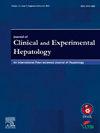Liver-related Events and Outcomes in Patients With Metabolic Dysfunction-associated Steatotic Liver Disease Varies With the Type of Cardiometabolic Risk Factor
IF 3.2
Q2 GASTROENTEROLOGY & HEPATOLOGY
Journal of Clinical and Experimental Hepatology
Pub Date : 2025-04-08
DOI:10.1016/j.jceh.2025.102559
引用次数: 0
Abstract
Background
The long-term impact of individual cardiometabolic risk factors (CMRFs) and their combinations on outcomes in patients with metabolic dysfunction-associated steatotic liver disease (MASLD) remains poorly defined.
Methods
In this single-center retrospective analysis, all consecutive patients diagnosed with MASLD from August 2001 to January 2024 were included. CMRFs were defined as per established criteria, with body mass index threshold of 23 kg/m2. Liver-related events (LREs) included ascites, hepatic encephalopathy (HE), variceal bleeding, hepatocellular carcinoma, and liver-related mortality. Rates of LREs and mortality were compared across CMRF combinations, and predictors were evaluated.
Results
Of 1395 screened patients, 1043 were analyzed (median follow-up: 5.3 (3.8–6.7) years). LREs occurred in 30 (2.9%) patients, with an incidence of 5.04 (3.48–7.30) per 1000 person-years (PY). All-cause mortality occurred in 32 (3.0%) patients, with an incidence of 5.36 (95% CI: 3.79–7.58) per 1000 PY, including 14 (1.3%) liver-related mortality. Among individual CMRFs, diabetes was associated with the greatest proportion of mortality (4.1%), LREs (7.0%), and extrahepatic events (4.5%), while dyslipidemia was associated with the lowest proportions (2.4%, 2.4% and 2.2%, respectively). Patients with all five CMRFs had the highest rates of all-cause mortality (13.6 per 1000 PY) and LREs (8.8 per 1000 PY), though these differences were not statistically significant compared to those with fewer CMRFs. When assessing CMRF combinations, those with hypertension, low high density lipoprotein, obesity, and diabetes had the highest LRE (17.4 per 1000 PY) and all-cause mortality (21.1 per 1000 PY). Liver stiffness measurement (LSM) ≥10 kPa was an independent predictor of LRE and all-cause mortality.
Conclusion
The type of CMRF plays a more critical role than the number of CMRFs in determining MASLD outcomes. Among the CMRFs, diabetes is associated with higher rates of LREs and deaths in patients with MASLD. LSM ≥10 kPa is a key predictor of clinical outcomes.

代谢功能障碍相关脂肪变性肝病患者的肝脏相关事件和结局随着心脏代谢危险因素的类型而变化
背景:个体心脏代谢危险因素(cmrf)及其组合对代谢功能障碍相关脂肪变性肝病(MASLD)患者预后的长期影响仍不明确。方法采用单中心回顾性分析,纳入2001年8月至2024年1月诊断为MASLD的所有连续患者。CMRFs按照既定标准定义,体重指数阈值为23 kg/m2。肝脏相关事件(LREs)包括腹水、肝性脑病(HE)、静脉曲张出血、肝细胞癌和肝脏相关死亡率。比较不同CMRF组合的LREs和死亡率,并评估预测因子。结果在1395名筛选的患者中,分析了1043名(中位随访:5.3(3.8-6.7)年)。LREs发生在30例(2.9%)患者中,发病率为5.04(3.48-7.30)/ 1000人年(PY)。32例(3.0%)患者发生全因死亡,发生率为5.36 / 1000 PY (95% CI: 3.79-7.58),其中包括14例(1.3%)肝脏相关死亡。在个体cmrf中,糖尿病与死亡率(4.1%)、LREs(7.0%)和肝外事件(4.5%)相关,而血脂异常与最低比例相关(分别为2.4%、2.4%和2.2%)。所有5种CMRFs患者的全因死亡率(13.6 / 1000 PY)和LREs (8.8 / 1000 PY)最高,尽管与CMRFs较少的患者相比,这些差异没有统计学意义。当评估CMRF组合时,高血压、低高密度脂蛋白、肥胖和糖尿病患者的LRE最高(17.4 / 1000 PY),全因死亡率最高(21.1 / 1000 PY)。肝硬度测量(LSM)≥10 kPa是LRE和全因死亡率的独立预测因子。结论CMRF的类型比CMRF的数量对MASLD预后的影响更大。在cmrf中,糖尿病与MASLD患者较高的LREs发生率和死亡率相关。LSM≥10kpa是临床预后的关键预测指标。
本文章由计算机程序翻译,如有差异,请以英文原文为准。
求助全文
约1分钟内获得全文
求助全文
来源期刊

Journal of Clinical and Experimental Hepatology
GASTROENTEROLOGY & HEPATOLOGY-
CiteScore
4.90
自引率
16.70%
发文量
537
审稿时长
64 days
 求助内容:
求助内容: 应助结果提醒方式:
应助结果提醒方式:


